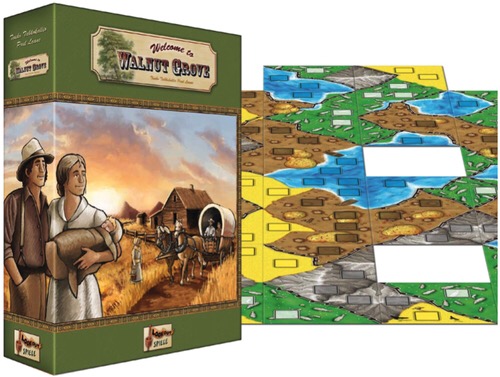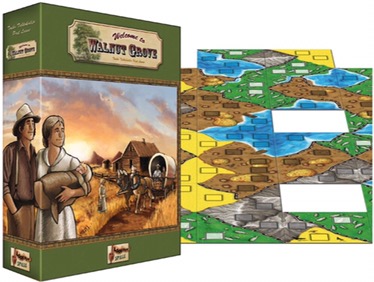
Walnut Grove could be described as a light mixing between Carcassonne and Agricola, merging tile laying with production. The game focuses on the development of player’s farms in 1885 in the Midwest. The better the farm, the more points you will score at the end of the game. Players can improve their farm during the game by adding new landscape tiles to it which open up new resources such as fish, cattle, stone, wheat and wood; which resources are used to feed your workers, improve and upgrade your homestead and barns and hire more workers.

The game play is made up of eight years, with each of those years being divided into four seasons including Spring, Summer, Fall and Winter with specific actions that are then enhanced or added to by notations on the year discs. As you can see in the picture below there are specific bonuses listed in the Summer phase (either getting +1 stone, +1 white good, etc.) as well as an extra benefit listed in the Fall phase where if you sell a specific type of good, you will gain an additional coin as a reward. This can be very powerful and must be taken advantage of in order to put yourself in position to gain end game victory points.

During Spring, players add landscape tiles to their farm after blindly drawing from 2-4 tiles and then being allowed to add 1 or 2 according to the current active year disc. During Summer, players place their workers on these landscape tiles to gather resources. When Fall comes, all players get to visit the nearby village of Walnut Grove where they can hire workers, buy improvements and upgrades and sell goods. Each player may do only one action while in the village though. The village is a kind of rondel that is divided into halves; each time you cross the midline you have to pay a coin, either your taxes near the Town Hall or tithes near the Church. Therefore it is wise to move as methodically as possible on the rondel with a plan in mind by considering what actions you want and need to take and must maximize those moves as you only have 8 such choices during the game. Each choice really matters and if you take the wrong action you can find yourself hopelessly behind! Finally, during the Winter phase, players need to feed their workers and heat their homes with wood in order to keep their workers happy so you must plan ahead on what type of resources to collect, how much food and wood you will need as well what actions you plan to take in the village!
The land areas will produce resources when you place the workers there during the Summer phase. Also, the tiles do not need to match when placed but you may want them to, as larger areas of the same resource type will give you greater production based on the number of tiles. For example in the below pic, the large wheat field (yellow) made up of 4 different tiles will produce 4 wheat with only one worker needed to be placed their while the adjacent lake to the left will only produce two white cubes with the same one worker being placed their. You also can score 1 point at games end per resource type that is made up of at least 2 different tiles that are completely fenced in such as the small lake mountain area adjacent to the large wheat field in the picture below.

Spring, Summer and Winter phases can be done simultaneously, providing fast game play. The game also works as a solo game, although I have not played it solo yet but plan to. One of the parts that I love about this game is that it can be played in 30-45 minutes as long as players have their actions planned and ready to go. I don’t believe their will be much analysis paralysis in the game for those that are prone to this as the decisions are few and fairly straight forward.
The game ends after the eight year, at which point players score victory points for coin value (a copper coin marked zero is not worth anything, whereas a silver is worth 1 and a gold is worth 2), as well as the number of workers and constructed huts and barns (including those that the players started with). There are also points that come from the various improvements that might allow you to score 2 points for all your improvements (The Tent), making your coins worth one additional point each (The Safe) or scoring a number of points for your largest group of landscape tiles (The Gateway). Most points wins the game. I like this game because it is refreshing to have a game that isn’t a “point salad” with 100 ways to score points and generally has ending scores in the 90’s. This game makes you earn your points and each one is very precious. Most games of Walnut Grove will end with a score in the upper 20’s or low 30’s.

Walnut Grove is a very well put together mid-weight Euro game made by a very talented design team, one of whom (Touko Tahkokallio) also produced Eclipse, which is a fantastic 4x space exploration game that our group loves and plays often. I would recommend this game as a potential purchase for anyone who regularly plays with groups who are looking for a quick, yet meaty worker placement game that requires foresight and planning to be competitive but is a little bit of a change of pace. Great components and fantastic mechanics make this a big surprise find for me and well worth the price of $10 that I paid for it at Origins 2016. I would recommend this to any group that loves worker placement and resource management. In our first game today, Alexander won while scoring 31 points (mostly from selling goods in the last few turns gaining 5 coins, several of which were gold giving him nearly 10 points with those coins), Tim came in 2nd with 21 points and I finished last with 20 points. We are looking forward to our next play of the game when we will have a better idea of the strategy involved and the need to plan out moves several moves in advance.
-Grant

A number of them are traders and professional players, plus
they many understand how to work the desk.
LikeLike